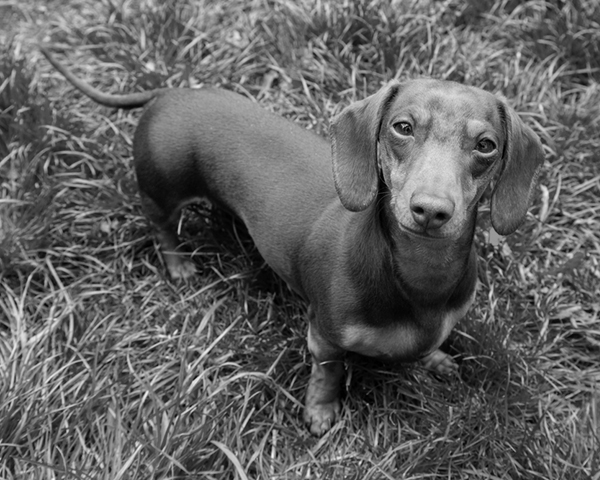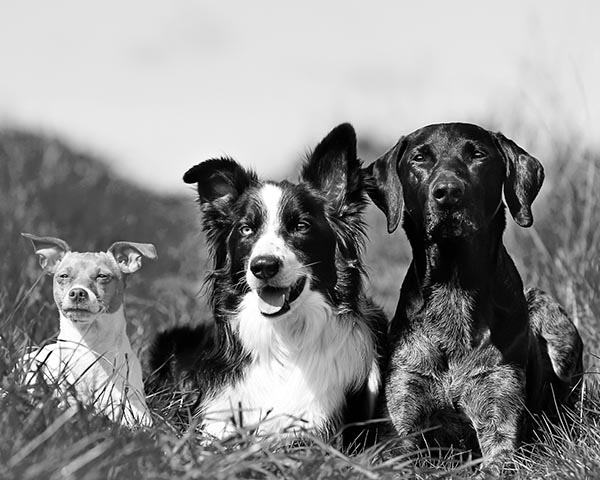Dachshund dog breed information and advice
Dachshunds may be small and cute, but they will surprise you with their fearless attitude and big personality. Don’t be fooled by their little legs either, the Dachshund breed loves lots of walks and playing games.
This breed guide will provide you with all the information you need to look after a Dachshund, from puppy to adulthood. From exercise and diet to grooming and their temperament, read on for handy tips on caring for the mighty sausage dog before bringing your new friend home.
Dachshund facts

| Lifespan | 12 - 16 years |
| How much | £700 - £2000 |
| Size | 20 - 28 cm Standard, 12.5 - 17.5 cm Miniature |
| Weight | 9 - 12 kg Standard, 4.5 - 5 kg Miniature |
| Colours | dapple, blue, silver, black, black and tan, chocolate,chocolate and tan, tan, cream, blue and tan, red, chocolate and cream |
| Grooming | weekly brushing |
| Temperament | fearless, stubborn and loving |
| Exercise | 45-60 minutes a day, split into two walks |
Insurance for your Dachshund
As fearless as a Dachshund is, they are not exempt from health issues or injuries. Due to the way they are bred, Dachshunds are prone to back problems. The most common health issues among the Dachshund breed are:
- Intervertebral disk disease (IVDD)
- Generalised progressive retinal atrophy (PRA)
- Lafora disease (LD)
It’s important to consider getting pet insurance to make sure your sausage dog is covered for these conditions, as well as the cost of vet bills for surgery and medication. It can also help with any ongoing expenses and vet visits.
When taking out a new pet insurance policy, please be aware that pre-existing conditions are not covered and policy limits, excesses and exclusions apply.
Sainsbury’s Bank Pet Insurance
With Sainsbury’s Bank Pet Insurance, you can choose from a range of insurance options for your Dachshund, including:
- Time limited – cover up to 12 months from first treatment or up to the vet fee limit, whichever comes first.
- Maximum benefit – cover of £3,000 or £6,000 towards vet bills per condition based on your level of cover.
- Lifetime – cover of £2,500, £5,000, £7,500 or £10,000 towards vet bills each year depending on your level of cover.
Sainsbury’s Bank puppy insurance can be taken out from as young as eight weeks old.
How to care for a Dachshund
When looking after your Dachshund, you’ll need to think about their health care. Regular vet check-ups and vaccinations are important but don’t forget that their diet, exercise, training and grooming routine can all affect their health.
Feeding and nutrition
Dachshund puppies need to be fed small amounts, 3-4 times a day. This can be reduced to two meals a day for adult dogs. It’s easy for Dachshunds to become overweight and as they’re small dogs, they only need to be fed a small amount of food. Follow the feeding guidelines on the food packaging to make sure you aren’t over or underfeeding your dog.
Grooming
Short, smooth-haired Dachshunds don’t need grooming as often as wire-haired and long-haired ones. Brushing your pet weekly will stop the fur from matting. It also helps to cut down on shedding.
When grooming your dog, check its eyes, ears and teeth to make sure there are no signs of infection. Give their eyes and ears a gentle clean using a damp cloth. You’ll need to brush your dog’s teeth daily, with a soft bristle toothbrush and dog toothpaste, to prevent gum disease. Don’t use human toothpaste as it’s toxic to dogs.
You may think that Dachshund clothing is just for appearance, but there is a more important reason for your dog to have its own clothes. Jumpers and coats will keep your dog warm during the colder months, and help to keep them clean when the ground is wet and muddy.
Exercise
Most people think that small dogs don’t need much exercise, but this isn’t the case for Dachshunds. Small and fast in quick bursts, Dachshunds were bred for running after badgers and foxes. They are used to lots of exercise and should be walked for 45-60 minutes per day, split into two walks. Exercise will help to keep your dog fit and at a healthy weight.
Training
Training Dachshunds can be a challenge as they are an independent breed and not always obedient. However, they were bred for hunting so can be trained with patience and dedication. Dog training classes are a good place to socialise your dog and pick up tips. By doing this from a young age, they will learn not to fear other dogs.
Puppies are easier to house train than adult dogs, so start their training early. Give them the chance to go to the toilet in the chosen toileting area regularly. This can be either a puppy pad or in the garden.
Temperament and behaviour
Despite their size, Dachshunds have a bold temperament. They are curious and have the instinct to hunt, so they are not always the most obedient dog. However, they do become attached to their family so won’t stray too far from their side when out of the house. Though they’re generally well-behaved, keep an eye on them when they’re alone in the garden as they do like to dig and could easily escape under fences.
Your neighbours may complain of barking if you leave your dog at home alone. Barking when alone is a sign of unhappiness, not bad behaviour. Dachshunds like to have company and they love to cuddle, so make sure you have plenty of time to show them affection.
Common health problems
The most common, well-known health issue linked to the Dachshund breed is a bad back. But there are other conditions that you should also be aware of.
Intervertebral disk disease (IVDD)
This condition affects the bones in the dog’s back (vertebrae). Intervertebral discs are pads between the vertebrae. These pads can bulge, rupture or slip out of place. This causes pain for the dog and they will not want to move. It can also cause paralysis, where your dog will be unable to move at all.
Strict cage rest will be needed with drugs to reduce the inflammation and pain. In some cases, surgery will be needed to sort the problem. It’s common for dogs, especially Dachshunds, to suffer from IVDD more than once in their life.
Generalised progressive retinal atrophy (PRA)
PRA is a hereditary disease that affects the dog’s sight. It leads to cataracts and blindness over months or years. Early signs of the condition include poor vision at night, nervousness in low lighting and big pupils. If a cataract develops, the eye will look cloudy.
Currently, there is no treatment available for this condition, but blind dogs can live happy lives for their full life expectancy
Lafora disease (LD)
LD is a form of epilepsy that is inherited. It’s a progressive condition, meaning it gets worse over time. Affected dogs have myoclonic seizures, which are brief jerks or shudder movements. They are usually awake during these seizures, but it can also happen when they are asleep.
The seizures are brought on by flashing lights, sudden movements or sounds that are close to the dog’s head. Affected dogs may struggle walking in sunlight. The condition is most common in the miniature wire-haired Dachshund.
Medication can be given to help reduce the seizures, but the condition is not curable. It’s not usually fatal, but it can lead to other health problems such as blindness and dementia.
So, is a Dachshund right for you?
This fearless, lively little character will melt anyone’s heart. With big puppy-dog eyes and a huggable body, who doesn’t like a sausage dog? This breed is best suited to someone with a lot of love and time to share with them. They may act tough, but they’re sensitive and gentle and should be handled with care.
Frequently asked questions
Do Dachshund shed?
All three of the Dachshund coats shed, but the wire-haired sheds the least. Brushing your dog regularly will reduce the amount of fur that falls out. It will also help to keep their coat clean and healthy.
How long do Dachshunds live?
The average life expectancy for a Dachshund is 12-16 years. This is the same for miniature Dachshunds. Their lifespan is affected by their diet, exercise and health problems. Overweight dogs are more likely to suffer from back, heart and joint problems.
What were Dachshunds bred for?
Dachshunds were bred to track down badgers and foxes and flush them out of their burrows. Miniature Dachshunds were bred to fit in smaller rabbit holes. Despite this, they’re not aggressive unless they feel threatened. They become attached to their owners and can become protective of them. Socialising your dog will help stop this from happening and becoming a problem.
Do Dachshunds have back problems?
Due to their short legs and long body, Dachshunds are prone to back problems. Jumping and climbing stairs puts pressure on their back. Stair ramps and dog stairs are designed to help Dachshunds get around and stop them from jumping. The best way to lift a Dachshund is to put one hand under their chest and the other hand around their rear end.

Browse our guides
Choose from our list of helpful guides and information

Explore dog breeds
Find out how to keep your dog healthy and happy

Cat breed guides
How to care for your cat, common health problems and more
References
Content provided from Vetstream's Vetlexicon Canis - www.vetstream.com/treat/canis 

Brooks D E, Williams D L & Gould D (online) Retina: generalized progressive retinal atrophy. In: Vetlexicon Canis. Vetstream Ltd, UK. Website: https://www.vetstream.com/clinical-reference/canis/diseases/retina-generalized-progressive-retinal-atrophy

Garosi L & Rusbridge C (online) Lafora disease. In: Vetlexicon Canis. Vetstream Ltd, UK. Website: https://vetstream.com/treat/canis/diseases/lafora-disease

Bagley R, Garosi L & Scott H (online) Intervertebral disk: type 1 herniation. In: Vetlexicon Canis. Vetstream Ltd, UK. Website: https://www.vetstream.com/treat/canis/diseases/intervertebral-disk-type-1-herniation

Vetstream Ltd (online) Progressive retinal atrophy (PRA) Owner Factsheet. In: Vetlexicon Canis. Vetstream Ltd, UK. Website: https://vetstream.com/clinical-reference/canis/owner-factsheets/progessive-retinal-atrophy-(pra)

Vetstream Ltd (online) Intervertebral disk herniation or slipped disc Owner Factsheet. In: Vetlexicon Canis. Vetstream Ltd, UK. Website: https://www.vetstream.com/clinical-reference/canis/owner-factsheets/intervertebral-disk-herniation-or-slipped-disk

Terms and conditions
Important information
* Guaranteed discount for Nectar members: The discount is based on information related to you and the transactions you've made with Sainsbury's supermarkets and Sainsbury's Bank using your Nectar card. For more information go to sainsburysbank.co.uk/nectar.
Sainsbury's Bank plc, Registered Office, 33 Charterhouse Street, London, EC1M 6HA (registered in England and Wales, no 3279730) is authorised by the Prudential Regulation Authority and regulated by the Financial Conduct Authority and the Prudential Regulation Authority (register no. 184514).
Sainsbury's Supermarkets Ltd is an appointed representative of Sainsbury's Bank plc. Sainsbury's Bank plc acts as an introducer to Pinnacle Insurance Ltd who is authorised by the Prudential Regulation Authority and regulated by the Financial Conduct Authority and the Prudential Regulation Authority (register number 110866). Registered office: 4th Floor, Limelight, Elstree Way, Borehamwood, Hertfordshire, WD6 1JH. Sainsbury’s Bank Pet Insurance is arranged, administered and underwritten by Pinnacle Insurance Ltd. Sainsbury's Bank plc and Pinnacle Insurance Ltd are not part of the same corporate group.
We do not provide personal recommendations to customers.
